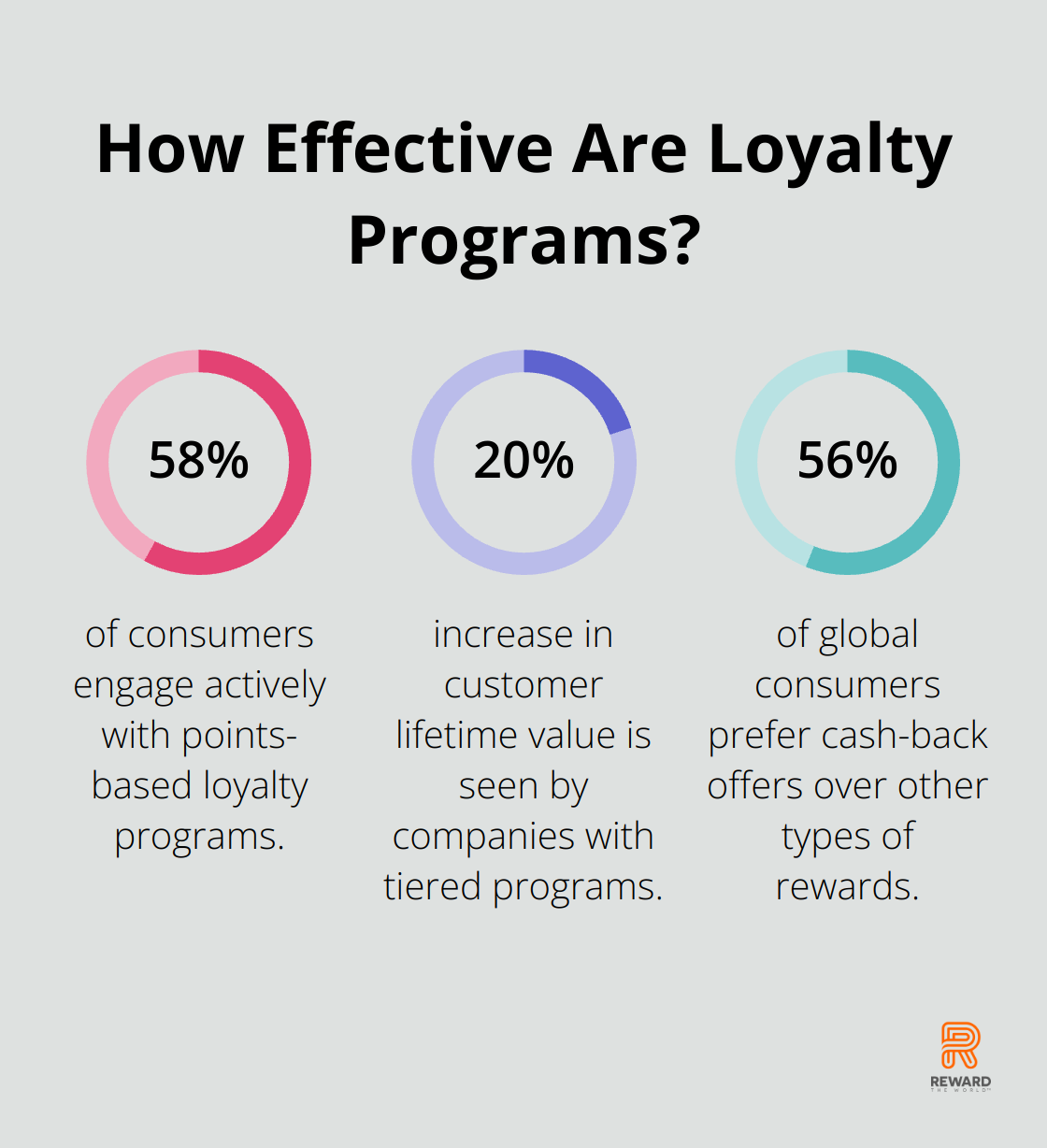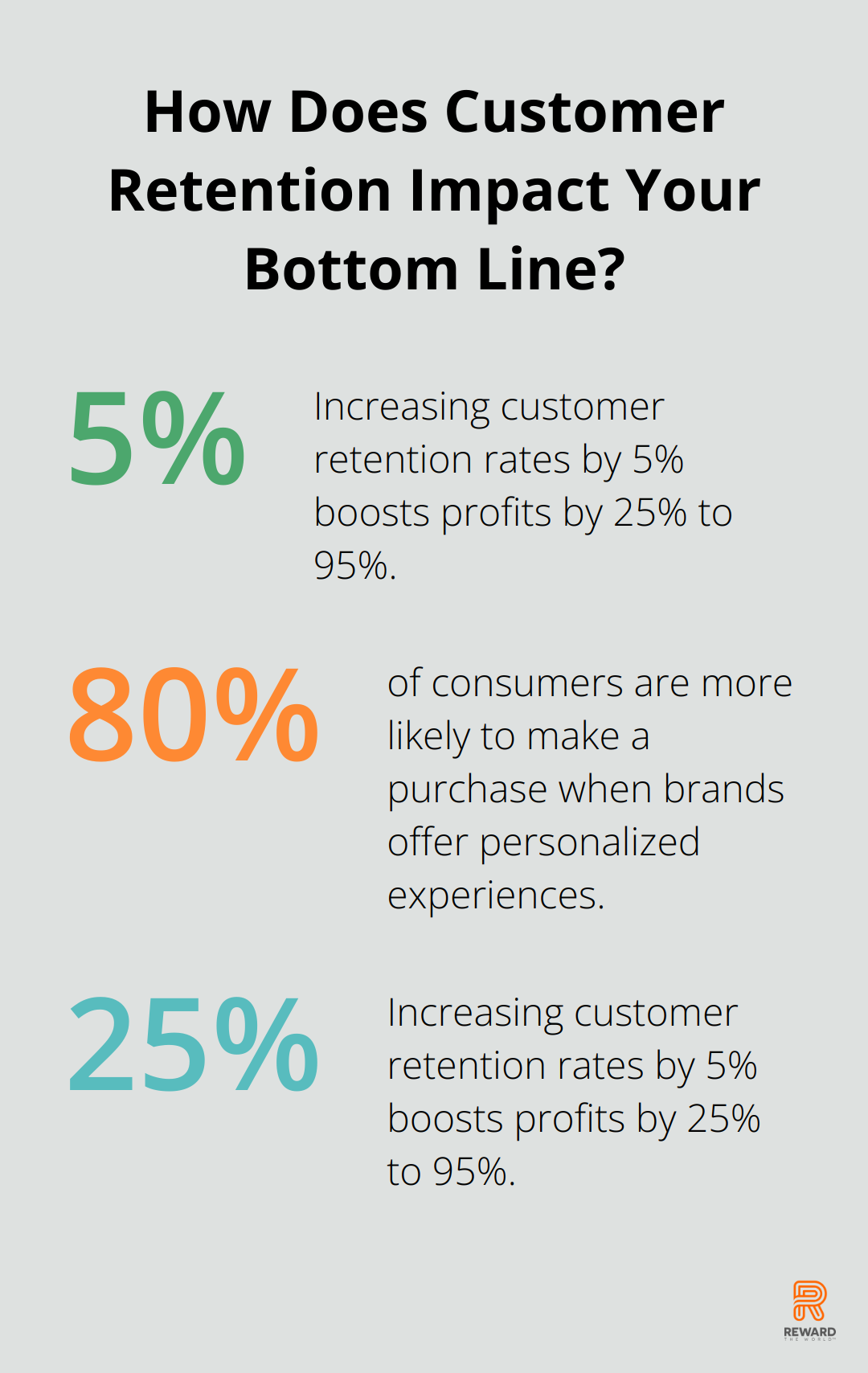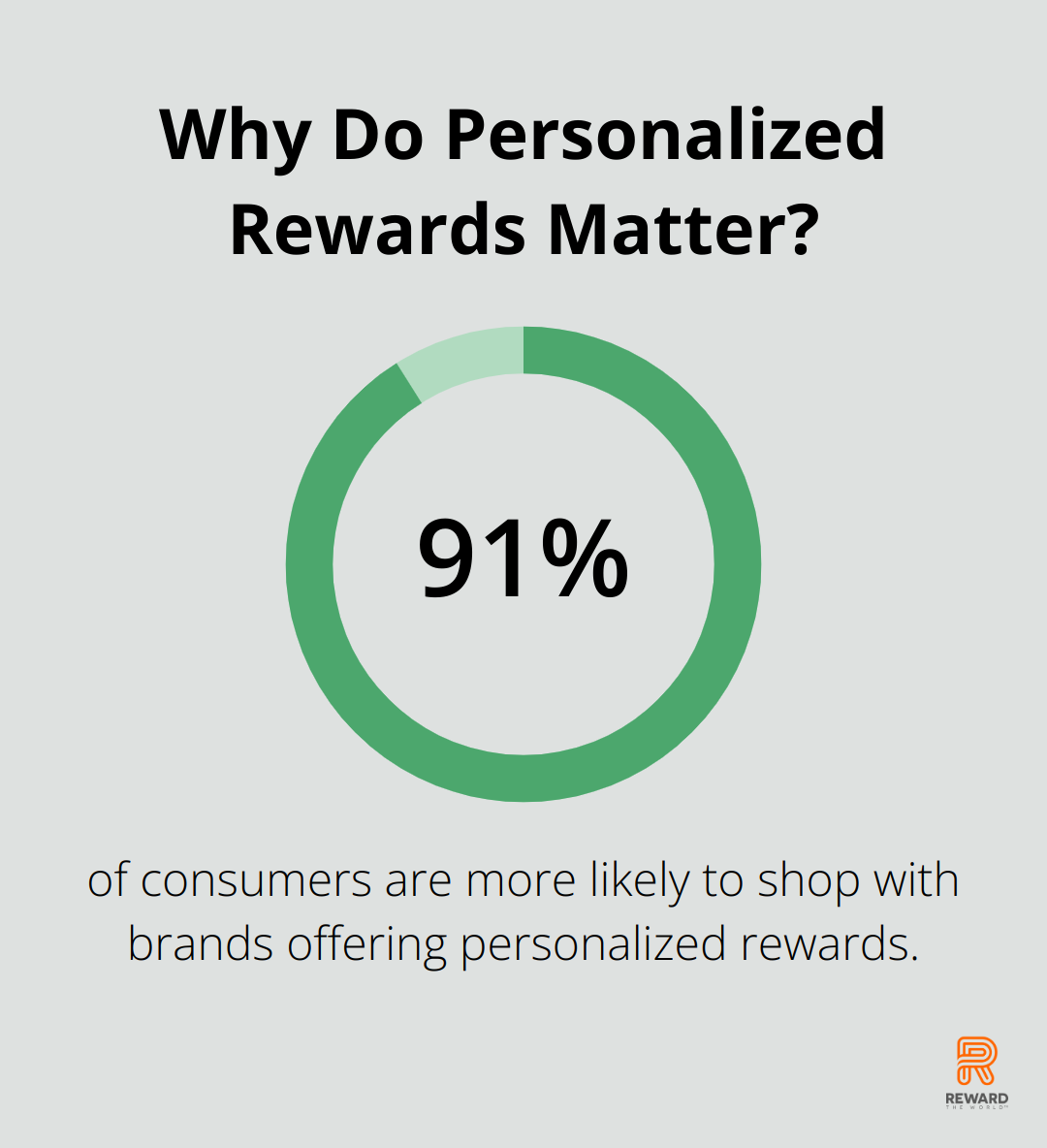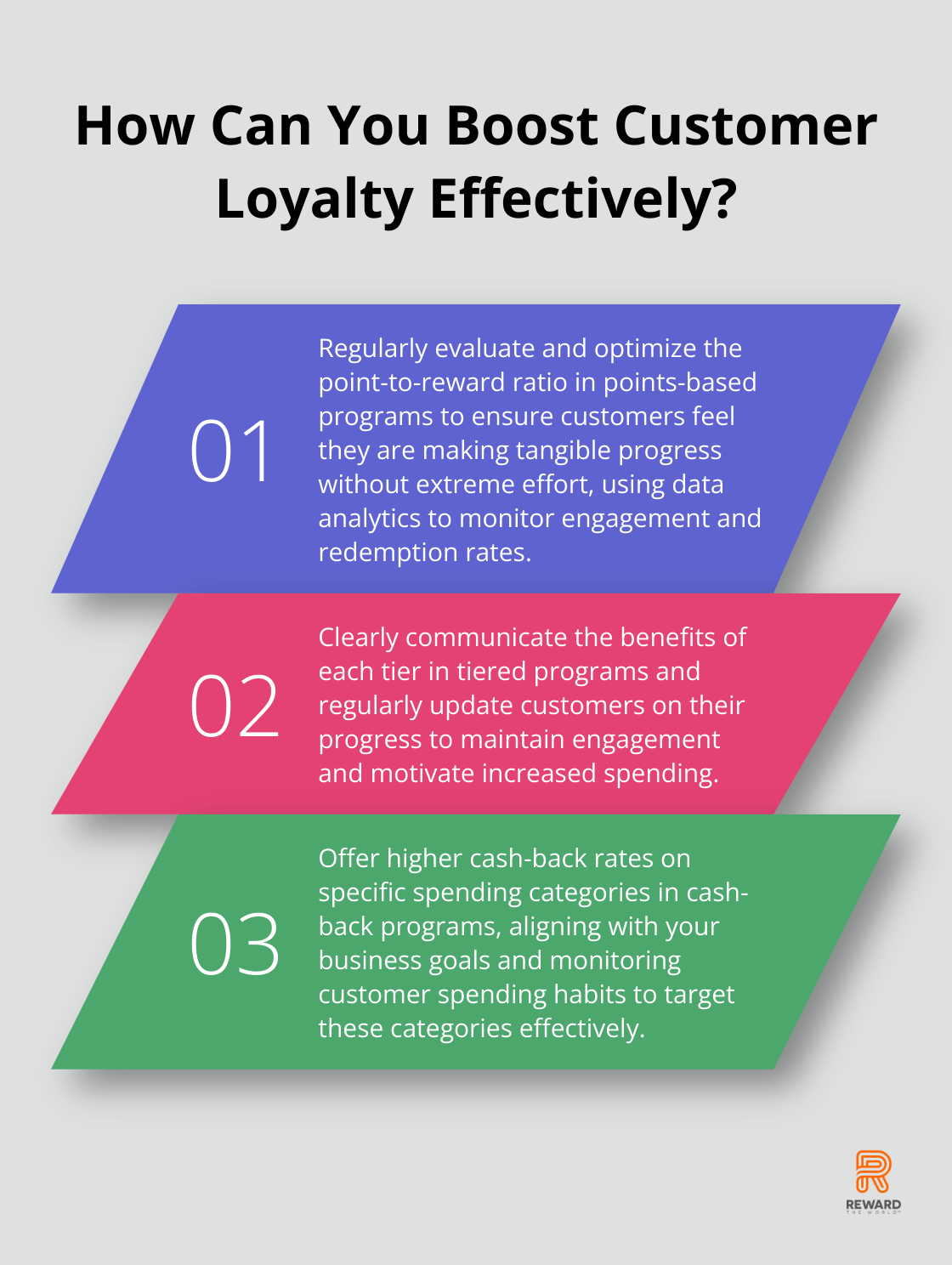
Understanding the various types of reward programs can significantly benefit your business by enhancing customer loyalty and driving revenue growth. Each strategy offers unique advantages tailored to different customer preferences.
We at Reward the World will explore how to implement these programs successfully, leveraging data analytics and personalized rewards. Through measuring key metrics, you’ll see the real impact on customer retention and business performance.
What Are the Different Types of Reward Programs
Points-based programs, tiered programs, and cash-back programs each offer distinct ways to engage and retain customers. Here’s how they work and why they can be effective for your business.
Points-Based Programs
Points-based programs are popular because of their simplicity and effectiveness. Customers earn points for every purchase, which they can later redeem for rewards. According to a study from Bond Brand Loyalty, 58% of consumers engage actively with points-based loyalty programs.

The success of these programs hinges on making point accumulation and redemption straightforward. For instance, Sephora’s Beauty Insider program allows customers to quickly rack up points and redeem them for free products, driving repeated purchases and fostering loyalty.
Practical Tip: Regularly evaluate the point-to-reward ratio to ensure the perceived value remains high. Customers should feel they are making tangible progress toward valuable rewards without extreme effort. Using data analytics to monitor engagement and redemption rates can provide insights into optimizing this ratio.
Tiered Programs
Tiered programs reward customers based on their level of engagement or spending. These programs create an incentive for customers to spend more to unlock higher levels with better rewards. The Starbucks Rewards program is a prime example. Customers start in a Green tier and can move to a Gold tier by accumulating stars, which encourages frequent visits and higher spending.
These programs not only increase customer spending but also enhance customer retention. In fact, companies with tiered programs often see a 20% increase in customer lifetime value compared to those without.
Practical Tip: Clearly communicate the benefits of each tier to your customers. Transparency about what customers need to achieve and the rewards they’ll earn can motivate increased engagement. Regularly update customers on their progress and the benefits waiting at higher tiers to maintain momentum.
Cash-Back Programs
Cash-back programs offer immediate, tangible rewards by returning a percentage of the customer’s spending back to them. This method is straightforward and highly valued by customers. A study by Nielsen indicates that 56% of global consumers prefer cash-back offers over other types of rewards.
This type of program can be particularly effective during economic downturns when customers are more budget-conscious. For example, Discover’s cash-back rewards card has consistently attracted customers by offering rotating categories for cash-back bonuses.
Practical Tip: To maximize the effectiveness of cash-back programs, consider offering higher cash-back rates on specific categories that align with your business goals. Monitoring customer spending habits can help identify which categories to target for maximum impact.
How to Implement a Successful Reward Program
Understanding customer preferences is crucial for a successful reward program. This involves gathering detailed data on your customer’s buying behavior, preferences, and feedback. According to a survey by Accenture, 91% of consumers are more likely to shop with brands that recognize, remember, and provide relevant offers and recommendations. To leverage this, consider using customer insights tools like Google Analytics, Hubspot, or Salesforce to collect and analyze customer data.
Personalizing Rewards
Personalization is key to making your reward program stand out. Tailored rewards can significantly improve customer engagement and loyalty. A study by Epsilon indicates that 80% of consumers are more likely to make a purchase when brands offer personalized experiences. Utilize CRM systems to segment your customers based on their purchasing habits and preferences. This allows for targeted rewards, such as exclusive discounts on products they frequently buy or early access to new items they’ve shown interest in. Tesla, for example, offers personalized rewards by providing early access to new models for their loyal customers.
Tracking and Analytics
Tracking the performance of your reward program is essential to understand its effectiveness. Key metrics to monitor include Customer Retention Rate (CRR), Redemption Rate (RR), and Net Promoter Score (NPS). According to Harvard Business Review, increasing customer retention rates by 5% boosts profits by 25% to 95%. Use tools like Tableau or Google Data Studio to visualize and analyze these metrics. If you notice a decline in engagement, it may be time to adjust your reward offerings or communication strategy. Regularly updating and tweaking your program based on data-driven insights can significantly enhance its performance and customer satisfaction. For more tips on effective tracking, read What Metrics to Track for Loyalty Program Engagement or B2B Reward Program Strategies.

How Effective Are Reward Programs?
To understand the real impact of reward programs, companies must measure specific metrics that reveal customer behavior and financial outcomes. This allows you to tweak and optimize your strategies for maximum effectiveness.
Customer Retention Rates
Customer Retention Rate (CRR) is a critical metric. A robust reward program should significantly improve your retention rates. Research from Bain & Company shows that increasing customer retention rates by just 5% can boost profits by 25% to 95%. Companies must track how many customers return after engaging with the reward program. Tools like Google Analytics or CRM software can help monitor these rates. If retention is lagging, consider refining your rewards or improving communication about program benefits.
Program Engagement Metrics
Engagement metrics provide insights into how customers interact with your reward program. Key indicators include participation rate, the frequency of use, and redemption rates. For instance, Bond Brand Loyalty’s study shows that 58% of consumers actively engage with points-based programs. Regularly analyze these metrics using data visualization tools like Tableau. High engagement suggests that the rewards resonate well with your customers. Conversely, low engagement may signal a need for adjustments in the program structure or value proposition.
Revenue Growth
Ultimately, the success of a reward program can be gauged by its effect on revenue growth. Effective programs not only retain customers but also encourage them to spend more. A study by Accenture reveals that 91% of consumers are more likely to shop with brands offering personalized rewards. Track the overall sales revenue and compare it to periods before implementing the reward program. Additionally, segment the data to see which customer groups are contributing most to revenue growth and tailor future offers to these segments. If the program does not drive significant revenue growth, reassess the rewards offered or the promotional strategies used.

By focusing on these key metrics, businesses can ensure their reward programs are not only keeping customers happy but also contributing to substantial business growth.
Conclusion
Understanding and implementing effective reward program strategies can profoundly impact your business. Points-based, tiered, and cash-back programs each offer unique ways to engage customers and foster loyalty. By leveraging data analytics and personalization, these programs can be tailored to match customer preferences, driving higher engagement and retention rates.

Effective reward programs have tangible benefits for businesses. As shown, increasing customer retention by just 5% can boost profits by 25% to 95%, illustrating the significant financial gains. High engagement rates with well-structured reward programs also suggest that customers value and respond positively to such initiatives.
Future trends in reward programs are likely to focus on more personalized and data-driven approaches. With 91% of consumers preferring brands that provide relevant offers, companies will increasingly use advanced analytics and CRM tools to fine-tune their strategies. Additionally, integrating robust tracking and visualization tools to measure key metrics will be essential for continual optimization and success.
At Reward the World, we offer a dynamic global incentives platform designed to enhance customer loyalty, sales conversions, and employee recognition. With a massive user base and instant reward delivery options, we provide a seamless, efficient, and cost-effective solution for businesses looking to boost engagement and performance. Explore more about Reward Program Strategies Explained with our services at Reward the World.
